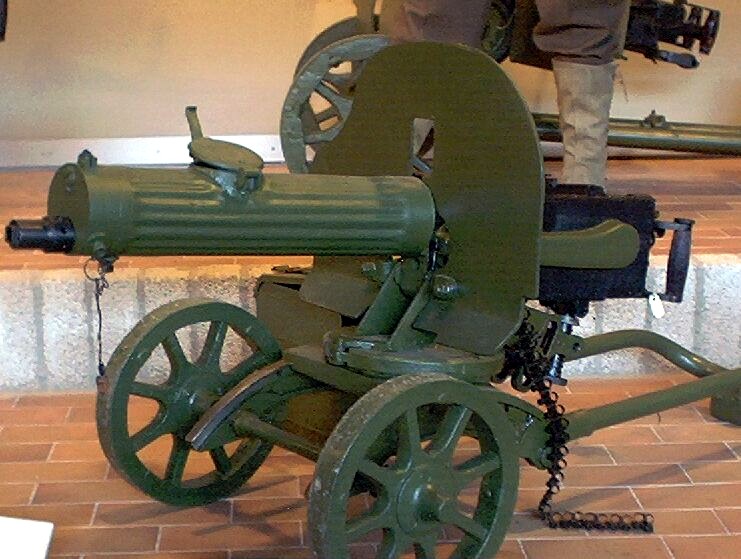The war in Ukraine has seen the resurgence of some decades-old weapons. Russia and Ukraine are using Soviet-made weapons produced in the 1960s and 70s, designed during the Cold War, and manufactured later. However, Ukrainian forces also use weapons dating back to World War 2 (WW2) and earlier.
One such weapon is the Pulemyot Maxima 1910 machine gun (or PM M1910), used by the Imperial Russian Army during World War 1 (WW1) and the Red Army during the Russian Civil War and WW2.
It was derived from the original Maxim, the world’s first fully automatic machine gun, created in 1884 by British-American inventor Hiram Maxim.
Imperial Russia acquired these guns from Germany and Britain, which proved to be quite effective during the 1904-1905 Russo-Japanese war, after which the decision was made to manufacture them in Russia. However, manufacturing did not start until 1910.

According to Encyclopedia Brittanica, the Maxim was mainly responsible for the WW1 being characterized as the ‘machine gun war.’
The M1910 Maxim In The Current Russia-Ukraine War
Videos and images began emerging in May, showing the M1910 Maxim machine gun used by Ukrainian forces to resist the invading Russian military.
#Ukraine: Tachankas of the Ukrainian army – a Maxim M1910/30 7.62x54R machine gun installed on a Soviet LuAZ-969 amphibious vehicle and operated by the Territorial Defense of #Zaporizhzhia.
TDF units are usually badly mechanized, so this is a way to increase firepower. pic.twitter.com/r5m0xVXTVC— 🇺🇦 Ukraine Weapons Tracker (@UAWeapons) May 25, 2022
The Russian media reportedly mocked Ukraine for using century-old equipment, implying that the country was running short of modern weapons. An Economist article reported that Ukrainian forces were using the M1910 machine gun by choice and not because of the lack of modern equipment.
While the M1910 is significantly bulkier than most modern guns with a weight of 68 kilograms and offers a much lesser firing rate of only 600 rounds per minute, it has something that makes it uniquely suitable for use in modern-day warfare: a water-cooling system.
Modern medium machineguns firing the similar 7.62mm rounds as the M1910 carry a fraction of the weight and are more portable, but they lack water cooling, and firing continuously, even for a minute, can cause them to overheat, leading their barrels to deform, or possibly even cause the ammunition to explode prematurely.
#Ukraine: UA breaking out the PM M1910 Maxim Gun once again. via @GirkinGirkin pic.twitter.com/Pt6dg2mY2g
— Cᴀʟɪʙʀᴇ Oʙsᴄᴜʀᴀ (@CalibreObscura) March 21, 2022
Therefore, they can only be fired in short bursts, and their operators may have to carry a spare barrel to switch in case of damage by overheating.
The M1910’s barrel is equipped with a brass water jacket that allows the machine gun to fire for extended periods continuously. Apart from that, the M1910’s fixed mounts make them easier to aim.
While the M1910 may have gained the spotlight after the Russian invasion of Ukraine, Ukrainian forces are known to have been using them at least since 2018, notably by the 92nd Mechanized Infantry Brigade.
In 2016, the then-Ukrainian defense minister General Stepan Poltorak authorized the release of some M1910s from government stocks.
According to an audit in 2012, Ukraine had 35,000 M1910s in storage – all produced between 1920 and 1950. Only a handful of these had been used since the onset of the war in Ukraine. The gun is not a standard issue but is provided when requested.
The M1910 is said to be effective in fixed defensive positions and fortifications. In 2016, a Ukrainian soldier said in an interview that the gun was highly accurate at one kilometer and effective up to three kilometers.
Some of the M1910s have also been modernized, with images circulating on social media of the century-old machine guns equipped with modern electronic red dot sights.
MadMax Steampunk LMG in Ukraine
Twin linked 7.62mm Russian made PM M1910 machine guns (from 1910-1945 !) fitted with Red Dot sight pic.twitter.com/Vw62WOeqXP— Harry Boone (@Harry_Boone) March 26, 2022
Apart from Ukrainian armed forces, Russian separatists in the Donbas region also use the M1910. Examples of guns have also emerged in other conflict zones like Syria and Vietnam.
Other Vintage Weapons Deployed By Ukraine
Ukrainian forces also use WW2-era field artillery weapons like the US-made M101 towed howitzers and the Russian-made D-44 guns developed in the 1940s.
The M101, which first began production in 1941, was the standard light field howitzer used by the US during WW2 and was deployed in European and Pacific theaters. It was also used during the Korean War.
As per the US Army’s website, the M101 can fire various types of ammunition, including high explosive, incendiary, armor piercing, smoke, and chemical shells.
The US ceased production of M101s in 1953 and phased them out entirely by 1989. They were widely exported to several countries, and many remain used worldwide.
The Ukrainian forces received a recent batch of M101s from Lithuania, as per an announcement by the Lithuanian Ministry of Defense on September 7.
Unlike the M1910 machine gun, nothing unique about the WW2-era artillery weapons positively distinguishes them from modern weapons.
#Ukraine: The first footage of a 105mm M101 howitzer, supplied by 🇱🇹 Lithuania to Ukraine earlier this year, in action with the AFU. Although these are older designs, more artillery is always useful-which is why Soviet WW2-era 85mm D-44 guns still make appearances. pic.twitter.com/2tQvMQ5Lkd
— 🇺🇦 Ukraine Weapons Tracker (@UAWeapons) November 27, 2022
Instead, they are only used for fielding more artillery weapons on the ground – as the tweet from the OSINT Twitter handle ‘Ukraine Weapons Tracker,’ reads, “more artillery is always useful.”
- Contact the author at tanmaykadam700(at)gmail.com
- Follow EurAsian Times on Google News